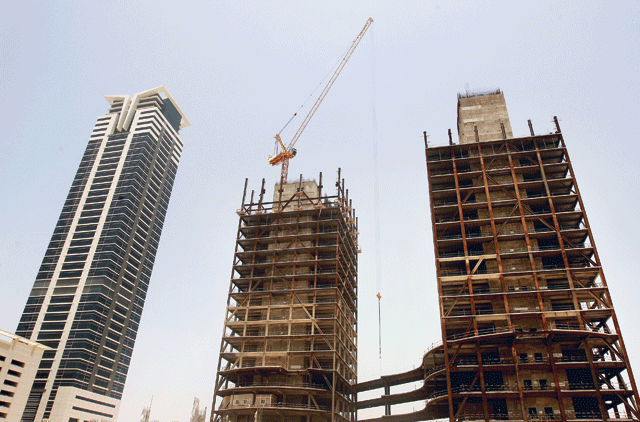
Dubai: Reviving half-built structures could be costly, but if maintained well over a period offers up a value proposition which could even attract future investments. As against that, opting for a total demolition of these structures translates into a pure loss.
"There is a lot of money in the foundation — if a building is only one-storey high one could opt to pull it down, but any higher than that could damage the foundation upon demolition," Tanmay Biswas, a C&S principal engineer at Meinhardt Dubai, said.
He was speaking at a recent seminar organised by law firm Taylor Wessing on the issue of stalled projects.
The option of reviving a project is not one to be treated lightly. A neglected half-built structure costs more to rectify and attracts other costs such as reapplication of permit.
Regulations may have changed as well. This are facts which will not escape a potential investor's attention.
"A half-finished building is worth zero despite the land value," said Fergal Harris, a director at Standard Chartered Bank. "We wouldn't know about the latent defects until we analyse the ghost building. The investor needs to establish an honest cashflow and completion timings."
Many make a case for re-engaging on the assumption of a good location and sales price, but tend to forget the cost of reconstruction. Then there are the legal implications which could raise the bill and cause delays to any future revival.
"There are legal issues over who takes responsibility when the structure is exposed to the elements during standstill," said Mark Fraser, partner at Taylor Wessing.
Although the issue of liability is addressed in Article 880 of the UAE's Civil Code, it does not take into consideration quality issues. Instead it says work needs to be completed within the conditions of the contract, Fraser added.
The contractor's liability lasts for ten years from handover of a building, while the owner or developer — not the end-user who would have to complain to the former — has three years to raise a complaint arising from defects.
The issue is further complicated when construction stalls, as the law excludes anything that is a temporary structure.
Engineering problems
The liability to protect the site would usually pass to the owner as a terminated contractor has no control over the site. "The new contractor is told to take on previous engineering problems," said Fraser.
"But it is unclear who would be responsible for latent defects. The lines between original and new contractors are blurred."
Biswas doubts the law is fair to ex-contractors, citing the example of slabs which are designed to withstand the duration of construction. But if stopped for many years, high temperatures could cause a latent defect.
"It may or may not happen, but you cannot hold the original contractor, engineers, etc., responsible," said Biswas. "They didn't design the building to stop construction. It is a grey area."
On another level, at least some of the stalled projects could be revived if contractors and developers enter into more than just a working partnership and consider a change of use if needed.
"I don't see any rejuvenation of unfinished buildings in 18 months or two years as banks are not lending, just like what happened in the Asian cities of Kuala Lumpur, Bangkok and Jakarta," said Fergal Harris, director SCCG, Standard Chartered Bank.
He was, of course, referring to the 1997 Asian crisis, where ghost buildings still scar parts of the skyline today. But construction on many was restarted when the market recovered in 2003.
But be prepared for potential investors to carry out extensive due diligence before considering a derelict building. "Pre-sold strata buildings won't work or be significantly harder to make them attractive to an investor," said Harris.
Pitfalls
"It would be difficult to get all of the owners' agreement for a re-design and so on. Outstanding payments to contractors and the likes would also slow down execution of a deal."
Some developers may offer contractors a stake in their projects if they are not able to pay or only partly pay outstanding receivables. But whether a contractor accepts - which could then be the ideal solution with the developer and contractor finishing the project as a joint venture - depends on the circumstances.
"In general contractors are risk averse," said Wayne Snow, senior client manager, risk management practice leader, Marsh Insco. "There has been one failed attempt for an alliance in the UAE. Usually there is a lot of finger pointing."
Legally, an unpaid contractor could try and freeze the asset, but would have to go through the courts. And there is no guarantee of he would end up winning. Said Jerry Parks, partner at Taylor Wessing, "There is no automatic right to take over the ownership of the asset."
A contractor, moreover, would not want to take over property if there is no value, but first find out who the lender is. And no one would want a building under a legal dispute.
"However, if an opportunity promises a huge upside suddenly a lot of willingness by all stakeholders to co-operate can be found," Harris added.
Although change of use is possible, it will increase cost and delay the construction programme as a new design will attract renewed construction permits from the authorities.
"One could easily change an office building with car park into a residence and a mall for example," Harris said. "But investors want to know the cost of restart, expect international standard yields and profits, and want to get something semi-completed finished as soon as possible."
Ensuring safety of the structure
Dubai : While stalled building structures can stay ‘alive' for ten years and more, they will still need adequate protection when construction restarts.
"Many expected deep degradation of the skyscrapers scarring the landscape in Asian cities during the 1997 financial crisis," said Mark Fraser, partner at Taylor Wessing, during a seminar the law firm organised recently. "But it didn't happen, many were restarted six to seven years later."
In Bangkok, buildings were revived after six years of standstill. But in the Middle East, the harsh climate and environment are factors that have a major say in how projects are built.
"The concrete gets affected by the salt in the air and extensive heat," Tanmay Biswas, a C&S principal engineer at Meinhardt Dubai, said. "It depends how porous the concrete is, it could last a year or two or more depending on the quality of built and whether protection is put in place."
But reviving a project is still possible. Concrete gets stronger over the years, all one needs to do is to cut the healthy parts and clean the rebar and steel.
Duration
"A structure is designed to survive exposure for the duration of construction 18 months to two years, after that the temporary design is not supposed to work," said Biswas. "After three to four years of stopping construction there is a risk of failure, security and accidents."
Recent data from Proleads suggests $5 billion worth of projects is currently on hold in Dubai. Some of these could be still on the drawing board, but around $150 billion worth of projects were started in the beginning of 2008 and around $20 billion in the third quarter of the same year.
Several have since run into financial difficulties and are in various stages of construction, from shoring and piling to near completion. And there are some with the mechanical and electrical engineering (MEP) works in place. An unstable structure could pose dangers to its surroundings.
Maintenance
Exposed rebar and steel need to be protected and even at the shoring stage serious problems can occur. Keeping the dewatering system is essential to avoid a site turning into a swimming pool, and avoid buoyancy pressure on the raft which would affect the piling.
Meinhardt Dubai's experience suggests that over 70 per cent of sites here have been abandoned without adequate protection in place. "Dewatering is expensive, protection doesn't cost as much, but there are owners who don't want to pay for maintenance and the consultant may not have specified the measures and stopped working on the project," Biswas said.
At the MEP stage, the issue of warranty creeps in. "If any plumbing or electrical work has already started, piping for example, they need to be protected to not degrade," Biswas added. "Pumps and other parts may lose their efficiency and stop working. The warranty for all of this work needs to be extended."
Interestingly, a building whose construction is stalled after being designed to sustainability standards could go either way if revived. It could lose its ‘green' ratings.












